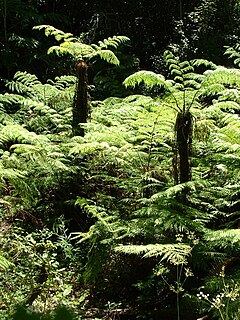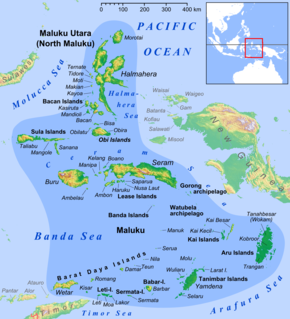
The Cyatheaceae are the scaly tree fern family and include the world's tallest tree ferns, which reach heights up to 20 m. They are also very ancient plants, appearing in the fossil record in the late Jurassic, though the modern genera likely appeared in the Cenozoic. Cyatheaceae are the largest family of tree ferns, including about 500 species. Cyatheaceae and Dicksoniaceae, together with Metaxyaceae and Cibotiaceae, are a monophyletic group and constitute the "core tree ferns". Cyatheaceae are leptosporangiate ferns, the most familiar group of monilophytes.
Cyathea alleniae is a species of tree fern native to the Malay Peninsula, where it grows in forest margin on steep ground at an altitude of approximately 1200 m. The trunk is erect, about 4 m tall and 15 cm in diameter. It is usually unbranched, but may branch to form several small crowns. Fronds are bi- or tripinnate and 1–2 m long. The stipe is spiny at the base and at least partially covered by scales. Typically of section Alsophila, these scales are dark brown, glossy, and have fragile edges. Sori occur near the midvein of fertile pinnules and are covered by firm, brown indusia that resemble scales in appearance.
Cyathea amintae is a species of tree fern native to Puerto Rico, where it grows in shaded areas and cloud forest at an altitude of 1000–1200 m. The erect trunk may be 1.3 m tall and approximately 5 cm in diameter. Fronds are pinnate and up to 1.6 m long. The rachis is often purplish brown and covered with scales, usually on the underside. The scales range in colour from golden brown to bicoloured. Sori occur along each side of the pinnule midvein and indusia are cup-like.

Cyathea australis, also known as the Rough Tree Fern, is a species of tree fern native to southeastern Queensland, New South Wales and southern Victoria in Australia, as well as Tasmania and Norfolk Island.

Cyathea capensis is a regionally widespread and highly variable species of tree fern. It is indigenous to Southern Africa and South America.
Cyathea crassa is a species of tree fern endemic to the Santo Domingo area in the Dominican Republic. Little is known about this rare tree fern.

Cyathea cunninghamii, also known as the gully tree fern and slender tree fern, is a species of tree fern indigenous to New Zealand including North Island, South Island and Chatham Islands; also to Victoria, possibly New South Wales, southeastern Queensland and Tasmania in Australia. It grows in damp forest, often emerging from stream gullies and riverbanks. Brownsey noted that it has a lower tolerance for drought than other species of Cyathea. The erect trunk may be 20 m tall and is usually 6–15 cm in diameter, occasionally as much as 20 cm. Fronds are tri- to tetrapinnate and 3 m or more in length. The rachis and stipe are slender, black brown, warty and covered with brown scales. Sori occur along each side of the pinnule midvein and are covered by hood-like indusia. C. cunninghamii is an uncommon and slow-growing tree fern.

Cyathea dregei is a widespread species of tree fern in southern Africa.
Cyathea elongata is a species of tree fern native to Venezuela and Colombia, where it grows in montane areas at an altitude of 2000–3000 m. The trunk is erect and up to 11 m tall. Fronds are pinnate and usually 2–3 m long. The rachis and stipe are brown, may be smooth to warty and have basal tan scales. Sori occur in small groups towards the base of the pinnule midvein and are covered by cup-like indusia.
Cyathea esmeraldensis is a species of tree fern which is endemic to Ecuador. It grows in coastal forest and forested slopes of the Andes.
Cyathea glabra is a species of tree fern native to Borneo, western Java, Sumatra and the Malay Peninsula, where it grows in lowland swamp forest and montane forest at an elevation of up to 1500 m. The trunk of this plant is erect and 2–4 m tall. Fronds are bi- or tripinnate and 1–2 m in length. Characteristically of this species, the lowest pinnae may be significantly reduced. The stipe is very dark and bears basal scales. These scales are dark, glossy and have a paler margin and fragile edges. Sori are produced in groups of one to three on fertile pinnule veins. They lack indusia.
Cyathea heterochlamydea is a little-known species of tree fern native to the islands of Luzon, Panay, Negros and Mindanao in the Philippines, where it grows in montane forest. The trunk of this plant is erect and usually up to 4 m tall or more. Fronds may be bi- or tripinnate and 1–2 m in length. The stipe is warty and/or bears short spines and scales. These scales are dark, glossy and have a narrow pale margin. Sori are borne near the fertile pinnule midvein and are protected by firm, brown indusia.
Cyathea hotteana is a species of tree fern endemic to Haiti, where it grows in cloud forest at an altitude of 1000–1200 m. The trunk of this plant is erect, up to 2 m tall, and approximately 8 cm in diameter. Fronds are pinnate and may reach 2 m in length. Brown basal scales cover the rachis and stipe, which are also brown. Sori are borne in two rows, one on each side of the pinnule midvein. They are covered by shallow, plate-like indusia, which bear one or two clefts at the margin.
Cyathea hunsteiniana is a species of tree fern endemic to eastern New Guinea, where it grows in rain forest at an altitude of 1300–2000 m. This species has a slender, erect trunk up to 1 m tall and about 3 cm in diameter. Fronds are bipinnate and approximately 1 m in length. Scattered scales cover the stipe. They are dark brown in colouration and have a broad paler margin and fragile edges. Round sori are borne one or two per fertile pinnule segment. The sori are protected by deep, firm indusia that are cup-like in appearance.
Cyathea imbricata is a species of tree fern endemic to Western New Guinea, where it grows in open forest at an altitude of 3240 m. The trunk of this plant is erect and approximately 2 m tall. Fronds may be bi- or tripinnate and are usually less than 1 m in length. The stipe is dark, spiny, and covered with caducous scales. These scales are glossy brown in colouration and have a paler margin and fragile edges. Sori are borne in groups of one to four per pinnule lobe. They are protected by firm indusia.

Cyathea incisoserrata is a species of tree fern native to the Malay Peninsula and the state of Sarawak on the island of Borneo, where it grows in forest and forest margins from the lowland to approximately 1250 m. The trunk is erect, about 4 m tall and 12 cm in diameter. Fronds may be bi- or tripinnate and 1–2 m in length. The stipe of this species is partly persistent and is sometimes retained on the upper trunk. It is warty, bears conical spines, and is sparsely covered with scales. These scales may be either small and fringed or bullate. Sori are borne near the fertile pinnule midvein. They are protected by very small, often bilobed indusia.
Cyathea kanehirae is a species of tree fern native to western New Guinea, where it grows in montane forest at an altitude of 1600–2700 m. The trunk of this plant is erect and 1–4 m tall. Fronds may be bi- or tripinnate and 1–2 m in length. The rachis is smooth, while the stipe is dark and warty. The stipe is covered with flat, brown, scattered scales. Sori are borne near the fertile pinnule midvein. They are protected by small indusia that are cup-like in appearance.
Alsophila is a section in the subgenus Cyathea. The name was originally applied to a genus of tree ferns which is now considered to be synonymous with Cyathea.

Cyathea smithii, commonly known as the soft tree fern or kātote, is a species of tree fern from New Zealand.











